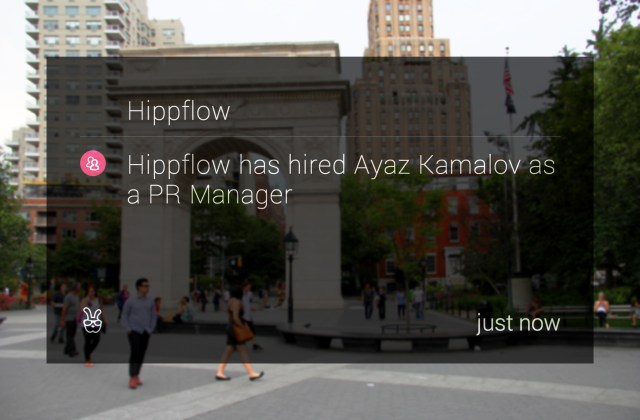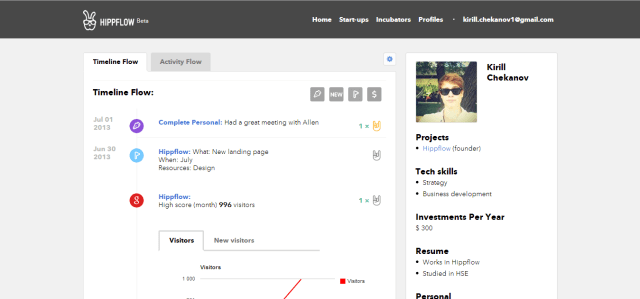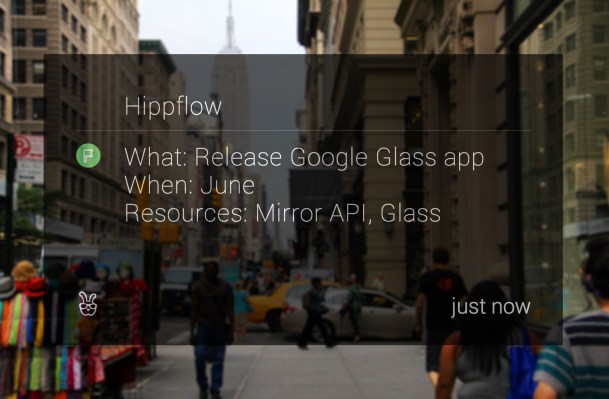Hippflow, which pitches itself as a ‘Twitter for startups’ with a service that makes it easy to update investors, mentors, team members and other stakeholders on a startup’s progress and future plans, has added support for Google Glass. The new Glass app brings Hippflow updates — pushed on the hour so as to help manage the ‘noise’ — to Google’s wearable computer once a user has linked their Hippflow and Google Glass account.
It may seem strange to build an app for Glass ahead of an iPhone or Android app, but Hippflow’s 18 year old Russian founder Kirill Chekanov is excited by the opportunities that Google Glass offers.
First, he notes that the Glass platform, in which ‘cards’ are used to display small snippets of information in a user’s peripheral vision, means that it fits with Hippflow’s status update modus operandi and overall mission to cut down on email to and from a startup’s investors and other stakeholders. A Hippflow milestone update and other types of startup updates work well within the confines of the Glass UI.
Second, Chekanov says that a Glass app enables him to reach a very defined group of target users (those in the Glass Explorer program), including some of Silicon Valley’s most prominent investors, founders and other influential early adopters within the startup world. Exactly the type of user that Hippflow has been designed for. “I want to thank Google,” he says, also revealing that he and his team actually built the first Hippflow Glass prototype ‘blind’ since he doesn’t have a Google Glass. Instead, he had to rely on help from others in the developer community for access to the Glass API. I guess that’s what it takes to be on the bleeding edge these days.

Zooming out further, Chekanov explains the genesis of Hippflow and the problem it’s setting out to solve came from his early experience of the pressure placed on founders to keep stakeholders updated. “After working with startups for a few years I’ve noticed that these guys have not that much time and tools to update investors fast and without losing time on old-school stuff like mail, Excel,” he says. “I wanted to help the community to experience an absolutely different way to do things, a way to do it in one click, organically, just as you breathe.”
In this way, Hippflow’s main competitor is email. Instead of a founder having to send out monthly or weekly email reports to investors and mentors to keep them updated on progress, problems and plans, or even things like major purchases and burn rate, these updates can be posted on Hippflow and appear in the startup’s timeline. Its various stakeholders can then ‘follow’ said startup, and while most updates will invariably be marked as private, updates can also be public, providing a nice way of keeping early adopters or perhaps crowdfunding backers in the loop.
For investors, it’s also a way to help their portfolio communications scale. “How do you track 10, 20, 50 companies? You need your data systematized,” says Chekanov. “This is a key to success. You want it on the go, short, good-looking.”

Used in a more public way, the other potential competitor is AngelList. “Comparing AngelList and Hippflow we compare Wikipedia and Twitter,” he says. “AngelList is an awesome tool for getting data about investors and startups. The AL team has done pretty good by putting the ‘venture game’ in the cloud. We give investors a brand new tool to get all sorts of updates from startups starting with releases and pivots, ending with burn rate and profits. Data could be marked as private if startups want to share it only with teammates and investors.”
Free to use, Hippflow has yet to flip the monetization switch. However, it plans to develop “a special system which will help startups to achieve the goals they’ve set,” says Chekanov. In addition, “service providers will pay for getting a chance to know a startup’s needs and help them to solve their pains.”
